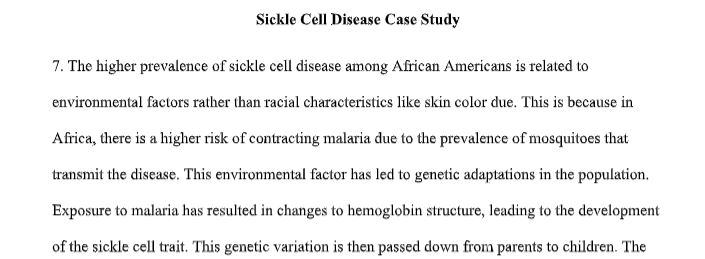Sickle Cell Disease Case Study
Sickle Cell Disease Simon and Althea Johnson met in high school. They became friends when they discovered, in a history class, that their families came from the same small town in South Carolina and that both were the grandchildren of slaves. Despite the fact that Simon and Althea were very healthy, Althea had difficulty conceiving and had three pregnancy losses before conceiving and giving birth to Edwin, their only child. Simon and Althea ran a restaurant in South Carolina for many years, and they lived into their nineties. Edwin married Yvonne, whose family is also descended from African slaves. They had daughters Naomi and Kizzy, who are very close, as are their daughters Suzanne and Tawanda. Naomi married Dan Cicero, whose family is from Italy, and Kizzy married Percival, a dark-skinned man from London. Fortunately, Naomi and Kizzy had no problems with fertility. Suzanne has three siblings and Tawanda has two. Dan and Naomi met at Duke University. When sickle cell disease carrier testing
was offered on campus, neither was interested. They were economics majors and had no background in biology, but remembered something from high school about only those of African ancestry inheriting or carrying the disease, and discrimination. No one in Naomi’s family had had the disease, and Dan wasn’t African American. They thought no more of sickle cell disease—until their first child, Robin, was born.
Shortly after Robin’s birth, the hospital called with startling news: the newborn had sickle cell disease. One of several dozen tests performed on blood taken from Robin’s heel had revealed the telltale abnormal hemoglobin S of sickle cell disease, although most of the hemoglobin was still of the fetal type. Dan and Naomi were shocked and confused. How could this have happened, given their family history?
Robin was started on prophylactic antibiotics to lower the risk of infection. She only had one “crisis.” It happened just after her first birthday, requiring hospitalization and transfusions to restore her circulation. In a sickle cell crisis, the misshapen red blood cells block blood flow, and the body part normally served by that blood vessel is cut off from the circulation, causing severe pain. Robin’s crisis affected her left arm. When Naomi became pregnant again two years later, she had amniocentesis, which provided fetal cells to test for the point mutation in the beta globin gene that causes sickle cell disease when homozygous. The fetus was found to be a heterozygote, and Jamal was healthy at birth. Naomi and Dan thought at first that the baby might be able to provide bone marrow for Robin, a fairly new approach that had cured a few children of sickle cell disease. However, Jamal could not provide marrow because some of his cells would be sickled, too. Dan and Naomi had two other children, one of whom was able to help Robin. The story continues in Chapter 21. Jamal became fascinated with his family’s illness. After college, he joined the
Peace Corps and was assigned to the Sudan. There, he met another volunteer, Keyonna, who was also a carrier for sickle cell disease. Their genotype was actually an advantage in their environment. Sickle cell disease carriers have a lower risk of contracting malaria because the parasites cannot survive in sickled cells, and a small percentage of their red blood cells are sickled. They have enough such cells to keep them safe from malaria, but not enough to cause sickle cell disease, unless they are at high altitudes where the body’s demand for oxygen intensifies. This protection explains why sickle cell disease is more common among certain population groups. Over the generations in Africa, the proportion of the population that carries the sickle cell disease mutation has increased, as it did in descendants who moved to other parts of the world where malaria existed. This protection against an illness that arises from heterozygosity for an inherited disease is termed balanced polymorphism
9. Identify a population group with a high prevalence of sickle cell disease other than Africans.
8. List other examples of balanced polymorphism.
From your course textbook In the Family: A Case Workbook to Accompany Human Genetics: Concepts and Applications, read the case study provided in the following chapter:
Answer Preview for Sickle Cell Disease Case Study

APA
600 Words
